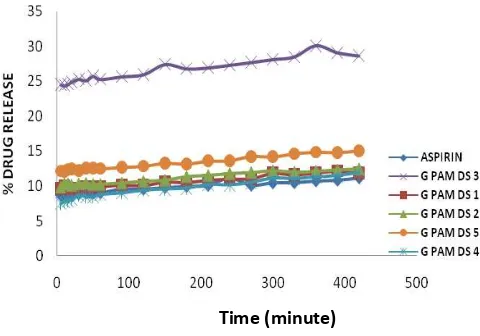The Synthesis of Carboxymethyl Amylose Grafted
Polyacrylamide and Its Application in Drug Release
Aspirin
Noor Hidayati, Naila Amanda, Karsono Samuel Padmawijaya, Firman Kurniawansyah, and Sumarno*
Chemical Engineering Department, Faculty of Industry Technology, Sepuluh Nopember Institut of Technology Surabaya Jl. Arief Rahman Hakim, Surabaya INDONESIA
*E-mail: [email protected]
Abstract :
Polyacrylamide as a biocompetible polymeric material can be used in modifying drug release of aspirin. But limitations in absorbing water on this polymer can be covered with the addition of carboxymethyl amylose which is having more hydrophilic properties and may assist in crosslinking. The incorporation of carboxymethyl amylose and polyacrylamide were carried out by grafting methods and used polymerized with solution method. The results of the synthesis of carboxymethyl amylose-g-polyacrylamide are expected to have a more controlled release of aspirin which may minimize the side effect of delivery. The results of the synthesis of CMA-g-PAM and its formation were characterized by FTIR, XRD, swelling degrees (DS), and percent grafting efficiency (% GE). CMA-g-PAM products are expected to have more hydrophifilic and more biodegradable properties. The research show that CMA-g-PAM was succesfully synthesize by this method. The evident can be seen in XRD analysis from peak and graph observation. With the value of %GE found on the CMA-g-PAM DS 3 can reach up to 98.14% with concentration of NaOH 1.5 M, and a reasonable degree of swelling presented in the concentration of 2.5 M NaOH is 5699.52.
Keywords: carboxymethyl amylose grafted polyacryamide, drug release, percentage of grafting, polycrylamide, starch.
1. Introduction
Aspirin can cause injury to the gastrointestinal tract by chelation of divalent metals and/or cations in the mucus ultivalen gastrointenstinal and mucosa, as a result of the chemical properties [1]. Shargel and Yu [2]
reported oral administration of aspirin tablets cause bleeding in the stomach. Therefore, aspirin should be coated with polymer to protect the stomach, so it will not be harmful and safe to consume.
The Ability to absorb water (swelling) in Polyacrylamide is limited. To improve the hydrophilic properties, grafting process is carried out with a hydrophilic polymer like amylose, which is perfectly soluble in water by heating at a maximum temperature of 60°C. Grafting to is used in this method because it can produce a high success rate of synthesis. In this research we used amylose derivative namely carboxymethyl amylose. These derivatives compounds have more hydrophilic properties than amylose. Variable to study is the variation of NaOH concentration in the synthesis of carboxymethyl amylose (CMA). Grafting process is expected to increase the solubility of polyacrylamide.
The current study focuses on controlled drug release system of aspirin. Process Polymerization is initiated by grafting to the carboxymethyl amylose by polyacrylamide. Grafting the polymer as well as polymer synthesis CMA at various concentrations of NaOH is expected to reduce the side effects of aspirin in the body. These results can be seen from the drug release aspirin test by using phosphate buffer as simulated in the gut. Beside other properties of the polymers are expected to remain held as a biocompatible, non-toxic and biodegradable.
2. Materials and Methods
2. 1 The materials used
Aspirin powder, NaOH solution, TEMED, K2S2O8, and chloroacetic acid.
2. 2 Variable of the research
Independent variables: the composition of NaOH; 0.5 M, 1.0 M, 1.5 M, 2.0 M; 2.5 M in the synthesis of Carboxymethyl amylose
2.3 Research Tools
Figure 1. Tools in Process Synthesis of CMA-g-PAM
Description:
Grafting method is used grafting to. This synthesis begins with the Synthesis of carboxymethyl amylose (CMA) and non-terminated polyacrylamide (nt-PAM). Then the process of grafting is between the CMA and the nt-PAM and the result is called CMA-g-PAM. The procedures for synthesis of CMA-g-PAM are as follows.
1. A total of 2.5 g NaOH concentration variation of CMA with a predetermined dissolved in 100 mL of distilled water in a stirred reactor and heated to a temperature of 60 ° C. Then cooled to room temperature. In the next phase, a mixture of nitrogen gas flows for 20 minutes.
2. Non-termination of polyacrylamide has been synthesized, inserted into a reactor containing solution of CMA.
3. Coupling reactions are performed in the reactor at a temperature of 50 ° C for 60 minutes.
4. The result of the polymer is placed in 1000 mL beaker glass. Then it is precipitated with acetone for 6 hours. The resulting product is called hydrogel. The homopolymer and the rest of the CMA that did not undergo the grafting remains in the filtrate.
5. Product formed gel is dried in an oven to dry.
Measurement of Degree of Swelling
The degree of swelling measurements performed to determine the ease of polymer dissolved in a solvent. 1. A total of 0.5 g of CMA-g-PAM was dissolved in 25 mL distilled water.
2. The degree of swelling measurements carried out at intervals of 2, 5, 10, 20, 60, and 120 minutes. Measurement of the degree of swelling using the following equation.
[1] Where B1 and B0 in a row are a heavy substance that has experienced severe swelling and early substance
Determination of the percentage of drug release
1. Measurements performed on the drug release in simulated gastric (gastinal fluid) and intestines (intestinal fluid). Measurement of drug release (DR) is done by using a spectrophotometric method. This method begins with the establishment of buffer solution.
2. Aspirin is inserted into the mixture of acid buffer (pH 1.2) and alkaline buffer (7.4) up to 900 mL [4]
3. The data absorbance measurements made at each interval on aspirin dissolution method of adjusting according to FDA, 2011 with modifications.
4. Subsequent measurement of each polymer is mixed with aspirin. Measurement steps starting from step 2. The percentage of drug release is determined using the following equation.
[2] Where Cn = concentration after correction, C'n = concentration and Cs is the concentration read before.
When you are corrected concentration (Cn) then to get the percentage of drug release (DR) using:
[3] Cn = concentration corrected, and Ct = Concentration of the theoretical
3. Results and Discussion
Carboxymethyl amylose grafted polyacrylamide (CMA-g-PAM) has been synthesized by grafting a nt-PAM on carboxymethyl amylose as the backbone. In the early stage of synthesized amylose, carboxymethyl amylose is reacted with a variation of the concentration of NaOH. The addition of NaOH is intended to augment the formation of carboxymethyl amylose. In the next phase, the synthesis of non-terminated polyacrylamide (nt-PAM) of acrylamide, without any termination process, is combined with the non-terminated polyacrylamide (nt-PAM) on carboxymethyl amylose’s backbone using the grafting to. The results obtained are CMA-g-PAM, which is then characterized on the degree of swelling as well as the performance of the drug release aspirin.
3.1. Swelling Results Analysis
The degree of swelling measurements carried out under acidic conditions (pH 1.2) and alkaline (pH7.4). The use of pH 1.2 and 7.4 of this suit the conditions of the body. At pH 1.2 is a simulation system in the acidic stomach. While conditions in the intestine performed at pH 7.4.
Figure 2. Results of swelling analysis CMA-g-PAM at pH 1.2
100
(%)
x
C
C
DR
t n
Figure 3. Results of swelling analysis CMA-g-PAM at pH 7,4
At pH 1.2 CH2COOH and -NH2 groups in CMA-g-PAM are be protonated –CH2COOH2 +
and –NH3 +
[5]. At pH 1.2 CMA-g-PAM polymer chains only stretch when the aspirin still covered in the composites polymer. Meanwhile, at pH 7.4, it shows that the degree of swelling of PAM is greater than at pH 1.2. At pH 7.4, hydrogel CMA-g-PAM undergoes a process of erosion that makes the aspirin released in the intestine where the aspirin is being absorbed, so the expected therapeutic effect can be achieved.
3.2. Drug Release Results Analysis
Figure 4 shows that the composite of CMA-g-PAM protect the stomach from aspirin because it has a lower value on drug release than the aspirin has. Whereas at pH 7.4 composite of CMA-g-PAM can effective release the aspirin. It can be seen from the value of aspirin drug release that is under the composite of CMA-g-PAM. This can be attributed to the degree of swelling. In the state of the stomach only occurs stretching the polymer alone, which resulted in the release of aspirin to be low. At pH 7.4-g-PAM CMA undergoes a process of erosion that aspirin regardless of the intestines resulting in higher release value in the gut.
Figure 4. Drug release profile of CMA-g-PAM at pH 1.2
Figure 5. Drug release profile of CMA-g-PAM at pH 7,4
4. Conclusion
Based on the research have been executed can be concluded that:
1. The value of the degree of swelling Increasing with increasing time. Where the greatest swelling at pH 7.4 2. CMA-g-PAM is proven to withstand the rate of release of aspirin in the stomach (pH 1.2)
3. CMA-g-PAM is proven to remove the aspirin of the intestine (pH 7.4) 4. CMA-g-PAM proved effective for targeted drug peleasan in the gut.
References
[1] Rainsford, K.D. (2004), Aspirin and Related Drugs, New York, Taylor and Francis Group.
[2] Shargel, L. and Yu, A.B.C. (1988), Applied Biopharmaceutics and Pharmacokinetics, Penerjermah Fasich, 1988, Biofarmasetika dan Farmakokinetika, Edisi kedua, Surabaya, Airlangga University Press.
[3] O idia , H. da Park, K. 8 , “ elli g Age ts a d De i es i Oral Drug Deli er , J. Drug Del. Sci. Tech., Vol. 18, hal. 83-93.
[4] FDA, 2007, Chapter-I Food and Drug Administration, Part 343: Internal Analgesic, Antipyretic, and Antirheumatic Drug Product for over the counter Human Use, Title 21, Vol. 5, http://www.accessda-ta.fda.gov/scripts/cdrh/cfdocs/cfCFR/CFRSearch.cfm?fr=343.80&utm_campaign=Google2&utm_source=fdaSearch&utm_ medium=website&utm_term=aspirin,%20dissolution&utm_content=2
[5] Assad, E., and Matees u, M.A. , The I flue e of Proto atio Ratio o Properties of Car o eth l “tar h Excipient at Various Substitution Degrees: Structural Insights and Drug Release Ki eti s , I ter atio al Jour al of Pharmaceutics, Vol. 394, hal. 75-84.



